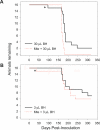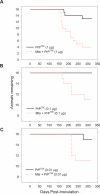Oral transmissibility of prion disease is enhanced by binding to soil particles
- PMID: 17616973
- PMCID: PMC1904474
- DOI: 10.1371/journal.ppat.0030093
Oral transmissibility of prion disease is enhanced by binding to soil particles
Abstract
Soil may serve as an environmental reservoir for prion infectivity and contribute to the horizontal transmission of prion diseases (transmissible spongiform encephalopathies [TSEs]) of sheep, deer, and elk. TSE infectivity can persist in soil for years, and we previously demonstrated that the disease-associated form of the prion protein binds to soil particles and prions adsorbed to the common soil mineral montmorillonite (Mte) retain infectivity following intracerebral inoculation. Here, we assess the oral infectivity of Mte- and soil-bound prions. We establish that prions bound to Mte are orally bioavailable, and that, unexpectedly, binding to Mte significantly enhances disease penetrance and reduces the incubation period relative to unbound agent. Cox proportional hazards modeling revealed that across the doses of TSE agent tested, Mte increased the effective infectious titer by a factor of 680 relative to unbound agent. Oral exposure to Mte-associated prions led to TSE development in experimental animals even at doses too low to produce clinical symptoms in the absence of the mineral. We tested the oral infectivity of prions bound to three whole soils differing in texture, mineralogy, and organic carbon content and found soil-bound prions to be orally infectious. Two of the three soils increased oral transmission of disease, and the infectivity of agent bound to the third organic carbon-rich soil was equivalent to that of unbound agent. Enhanced transmissibility of soil-bound prions may explain the environmental spread of some TSEs despite the presumably low levels shed into the environment. Association of prions with inorganic microparticles represents a novel means by which their oral transmission is enhanced relative to unbound agent.
Conflict of interest statement
Figures





Similar articles
-
Prions adhere to soil minerals and remain infectious.PLoS Pathog. 2006 Apr;2(4):e32. doi: 10.1371/journal.ppat.0020032. Epub 2006 Apr 14. PLoS Pathog. 2006. PMID: 16617377 Free PMC article.
-
Estimating prion adsorption capacity of soil by BioAssay of Subtracted Infectivity from Complex Solutions (BASICS).PLoS One. 2013;8(3):e58630. doi: 10.1371/journal.pone.0058630. Epub 2013 Mar 4. PLoS One. 2013. PMID: 23484043 Free PMC article.
-
Fate of prions in soil: a review.J Environ Qual. 2011 Mar-Apr;40(2):449-61. doi: 10.2134/jeq2010.0412. J Environ Qual. 2011. PMID: 21520752 Free PMC article. Review.
-
Direct detection of soil-bound prions.PLoS One. 2007 Oct 24;2(10):e1069. doi: 10.1371/journal.pone.0001069. PLoS One. 2007. PMID: 17957252 Free PMC article.
-
Insights into prion strains and neurotoxicity.Nat Rev Mol Cell Biol. 2007 Jul;8(7):552-61. doi: 10.1038/nrm2204. Nat Rev Mol Cell Biol. 2007. PMID: 17585315 Review.
Cited by
-
Cervid Prion Protein Polymorphisms: Role in Chronic Wasting Disease Pathogenesis.Int J Mol Sci. 2021 Feb 25;22(5):2271. doi: 10.3390/ijms22052271. Int J Mol Sci. 2021. PMID: 33668798 Free PMC article. Review.
-
Oral Ingestion of Synthetically Generated Recombinant Prion Is Sufficient to Cause Prion Disease in Wild-Type Mice.Pathogens. 2020 Aug 13;9(8):653. doi: 10.3390/pathogens9080653. Pathogens. 2020. PMID: 32823763 Free PMC article.
-
Lichens: unexpected anti-prion agents?Prion. 2012 Jan-Mar;6(1):11-6. doi: 10.4161/pri.6.1.17414. Prion. 2012. PMID: 22453171 Free PMC article. Review.
-
Potential role of soil properties in the spread of CWD in western Canada.Prion. 2014 Jan-Feb;8(1):92-9. doi: 10.4161/pri.28467. Prion. 2014. PMID: 24618673 Free PMC article.
-
Soil clay content underlies prion infection odds.Nat Commun. 2011 Feb 15;2:200. doi: 10.1038/ncomms1203. Nat Commun. 2011. PMID: 21326232 Free PMC article.
References
-
- Watts JC, Balachandran A, Westaway D. The expanding universe of prion diseases. PLoS Pathog. 2006;2:e26. doi: 10.1371/journal.ppat.0020026. - DOI - PMC - PubMed
-
- Zou WQ, Gambetti P. From microbes to prions: The final proof of the prion hypothesis. Cell. 2005;121:155–157. - PubMed
-
- Hoinville LJ. A review of the epidemiology of scrapie in sheep. Rev Sci Tech. 1996;15:827–852. - PubMed
-
- Greig JR. Scrapie: Observations on the transmission of the disease by mediate contact. Vet J. 1940;96:203–206.
Publication types
MeSH terms
Substances
Associated data
- Actions
LinkOut - more resources
Full Text Sources

